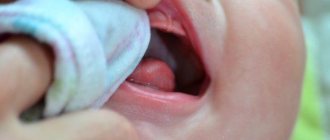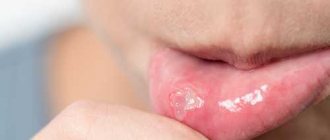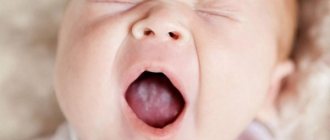What does thrush look like in a child?
Any part of the oropharynx can be affected: tongue, lips, corners of the mouth, gums, mucous membranes of the cheeks, palate, pharynx, tonsils. White grains (spot coating) appear, reminiscent of curdled milk, or a film (solid coating) of a cheesy appearance. These elements are easily removed by scraping with a spatula, revealing a bright red base, sometimes with a bleeding surface. As a rule, the course of the infection is painless and has only local manifestations. General health is not affected.
Symptoms of thrush in the mouth in infants and children
Signs of candidiasis in babies vary depending on the stage of the disease and may appear 5-10 days after birth.
Symptoms of the first phase of the disease are disturbances in the psycho-emotional state (tearfulness) and the appearance of plaque. It is difficult to remove pathological formations that look like small white dots. The child refuses to take the breast and is capricious.
As thrush develops, deposits spread beyond the mouth and become localized in the throat.
The plaque acquires a cheesy consistency, looks like dense white plaques, and cannot be removed. The child's mouth smells unpleasant.
Stage three thrush in infants is accompanied by the following symptoms:
- deposits cover the throat, lips, tonsils, palate, gums, cheeks;
- upon palpation, enlarged lymph nodes are felt;
- identified ulcers are characterized by increased bleeding.
The baby is worried, constantly cries, and refuses to eat. Additional signs include fever up to 37.5 °C, lethargy, the presence of allergic reactions, and a strong odor from the child’s mouth. The disease spreads to the tissues of the gastrointestinal tract and manifests itself in the genital area. The plaque may take on a yellow or brown tint.
How to treat thrush in a child?
The disease is treated at home. Local medications are used and only as prescribed by a doctor: pediatrician or dentist! Special antifungal agents are used in the form of solutions, sprays, gels, and drops. For maximum effectiveness of therapy, the drug must remain in the oral cavity (on the mucous membrane) for as long as possible. Therefore, the main way to use them is by rinsing or lubricating.
Treatment is long, up to 2-3 weeks.
It is important!
Often thrush in the mouth of infants is associated with candidiasis of the skin of the nipples and areola in the mother. In this case, the woman experiences redness, irritation, and a burning sensation on her chest. In this case, treatment should be comprehensive, for mother and baby.
Symptoms of candidiasis
Most often, candidiasis occurs in newborns and preschool children.
The older the child, the less often the disease is diagnosed. The favorite place for thrush to appear is the oral mucosa. A cheesy coating appears on the gums, palate, and inside the cheeks, and the baby feels pain and itching when eating. Along with these symptoms, candidiasis in children is also characterized by other signs:
- redness of the mucous membrane;
- ulcers that open after removing the cheesy plaque;
- loss of appetite;
- general weakness;
- white coating on the tongue.
The child does not eat well and is often capricious, since any touch to the mucous membrane causes pain.
In advanced cases, bleeding wounds open at the site of the removed plaque. There is another common form of candidiasis - fungal tonsillitis. It develops as a result of improper treatment of protracted sore throat. Characteristic symptoms of the disease are a cheesy coating on the tonsils and a burning sensation in the throat.
When the skin is infected with fungi, dense spots, redness, and blisters appear on it. In adolescents, thrush often affects the mucous membrane of the genital organs, and the disease is more typical for girls. Vaginal discharge becomes white and thick. In boys, the head of the genital organ turns red, and a discharge similar to sour cream appears in the area of the urethra. Cystitis and urethritis may develop.
If fungi infect the digestive tract, the child begins to suffer from colic, and food is difficult to digest. The baby suffers from constipation and pain in the lower abdomen. If fungi colonize the respiratory organs, the child often suffers from bronchitis, pneumonia, and ARVI. If internal organs are damaged, treatment should begin immediately, in consultation with a pediatrician.
Child nutrition
Simple carbohydrates are the main nutrient medium for fungal growth. Therefore, sweets, sugar, cookies, etc. must be excluded from the patient’s diet. Breastfeeding certainly continues.
If the child is bottle-fed or mixed-fed, then preference should be given to formulas containing probiotic microorganisms, which have the largest evidence base for their effectiveness. These are LGG and BB-12 from Chr. Hansen. It has been proven that LGG and BB-12 inhibit the growth of opportunistic microorganisms and fungi, protect against the development of caries and infections, and effectively prevent atopic eczema. Nutrilak Premium Comfort is enriched with LGG probiotic.
Treatment of thrush with medications
If the treatment is prescribed correctly, then after a couple of days the child will feel much better even with a severe form of the disease. However, this does not mean that taking the drug should be stopped - it is necessary to complete the full course of treatment until all symptoms of candidiasis are eliminated.
Thrush that is not completely treated is at risk of returning during the next vaccinations or during the baby’s teething period. During such periods, do not use the previously prescribed medication yourself and under no circumstances increase the dosage of the medications. After all, an increased dose of an antiseptic can provoke the opposite effect - the occurrence of bacterial stomatitis due to the proliferation of pathogenic microflora. Independent and uncontrolled use of medications is always risky because beneficial bacteria living on the surface of the mucous membranes may die, and their place will quickly be taken by pathogenic microorganisms. Therefore, wait for a doctor’s appointment, who will accurately determine the required dosage of the drug.
In addition, in parallel with drug treatment, do not forget about treating your baby’s nipples, bottles and toys: they can be regularly boiled and kept in a soda solution. When breastfeeding, do not forget to wash your nipples before each time your baby latches on.
Breastfeeding with thrush
If you are breastfeeding, thrush can cause a lot of discomfort for you and your baby.
It is important to start treatment as soon as possible, so go to the doctor as soon as possible to confirm the diagnosis and prescribe treatment. Please note that symptoms may not go away immediately.
Experts recommend not stopping breastfeeding if you have thrush. Here are some ways to relieve discomfort without interfering with your milk supply:
- Try to have shorter feedings, but more often.
- Wash your nipples with water after each feeding and dry them before putting on a bra.
- If cracked nipples make breastfeeding painful for you, try expressing milk and giving it to your baby from a small cup.
- Pain can be relieved with medications. Talk to your doctor about which medications are safe to take while breastfeeding.
Other reasons
Sore breasts and nipples are not always caused by thrush. If you experience sharp pain in your breasts during or after feeding, or severe pain in your nipples, try changing your feeding position or letting your baby latch on again. Sometimes this is enough to relieve the pain.
If cold compresses or air baths increase the pain, the cause of the pain may be contraction of the blood vessels in the nipple area.
Another cause of pain may be mastitis - inflammation of the mammary gland due to stagnation of milk, poor emptying of the mammary gland, as well as a cracked nipple.
These conditions are often confused with thrush, so you should visit a doctor who can pinpoint the cause of your discomfort.
FAQ
- In some babies, thrush causes inflammation in the mouth, as well as pain and discomfort during feeding. But many babies do not experience any discomfort.
- In some cases, thrush may go away on its own, but it is important to see a doctor as he or she may prescribe antifungal treatment.
- If the corners of your baby's mouth are cracked or you notice white spots on the tongue, lips, or inside the mouth, it may be thrush. Another sign of thrush is discomfort or pain during feeding.
- Doctors usually prescribe antifungal medications to treat thrush in children. If thrush appears in the mother or one of the family members, it is important to treat everyone at the same time to avoid transmitting the infection to the baby.
Life with a baby is full of surprises. One minute you are touched by that first toothless smile, and the next minute you look anxiously into the baby’s mouth.
Thrush in infants is a common problem that parents face. Just follow the doctor's recommendations, and everything will gradually pass, and you and your baby will be able to enjoy moments of closeness during feeding again.
How to diagnose thrush?
For a doctor to diagnose “oral candidiasis” in a child, it is enough to observe the clinical picture of this disease. The mucous membranes throughout the oral cavity are covered with a white coating in the form of small dots. Gradually these dots merge into large white spots. They cause poor sleep, refusal to eat, and frequent regurgitation. Visually, they look like curdled milk, which is why candidiasis is called thrush.
- Thrush or vulvovaginal candidiasis. Symptoms and treatment
About oral candidiasis in children
Additional tests are usually not required to determine the disease. Local therapy is prescribed.
Important! A quick positive result of therapy indicates a correctly made diagnosis.
A complete diagnosis of thrush in children is carried out using such studies.
| Type of study | Description |
| Microscopic | Scrapings are taken from the mucous membranes of the mouth, and the resulting material is examined under a microscope. In this way, cells and threads of Candida fungi are detected |
| Bacteriological | Sowing is done on a nutrient medium for the growth of bacteria, the type of fungi and the number of their colonies are determined. To select the most suitable antifungal drug, the reaction of the identified type of fungus to their action is checked. Such an analysis must be done in cases where the prescribed drug does not provide a therapeutic effect. |
| Serological | The study of antibodies in human serum, based on certain immune responses. Detection of antibodies to the causative agent of this bacterium allows us to determine the presence of a specific type of fungus. |
Serological study
Diagnosis of thrush
“SM-Doctor” is a multidisciplinary medical center specializing in the identification and treatment of all types of diseases in children from 0 to 18 years old.
Thanks to modern equipment and experienced staff, our clinic provides patients with a full range of diagnostic services. This ensures quick and high-quality detection of thrush. The doctor can diagnose fungal infection of the mucous membranes during the initial examination of the child. After collecting anamnesis and analyzing the patient’s complaints, the doctor assesses the condition of the affected area of the body. If a characteristic plaque is detected in combination with the above symptoms, a preliminary diagnosis is made. To confirm it, the following additional procedures are used:
- microscopic analysis of scrapings from the affected area of the mucous membranes;
- traditional laboratory tests - general and biochemical analysis of blood and urine.
If there is a suspicion of concomitant somatic pathology, the doctor may refer the child for consultation to related specialists. Sometimes weakened immunity can be a consequence of gastritis, cholecystitis or other diseases of the internal organs.
What is Candida fungus?
The body is a very smart system. With the help of immunity, it controls the reproduction and development of foreign organisms. Healthy microflora of the human body inhibits the rapid development of Candida fungus and helps limit their pathological growth, which can cause harm. Hormonal imbalances, taking antibiotics, and dysbacteriosis lead to a decrease in immunity, and the body ceases to control the proliferation of bacteria. This leads to the formation of inflammatory processes, which, in turn, cause damage to the mucous membranes of the mouth.
Infection of the oral mucosa of a child with thrush
Important! The child's body does not yet have a fully formed intestinal microflora. His immunity is just beginning to develop. This explains why thrush occurs most often in young children.
Pathological proliferation of Candida fungi in the oral cavity leads to the appearance of candidiasis. This is accompanied by the appearance of numerous small white dots on the baby’s oral mucosa. They can be easily seen when the child is crying or eating. When in doubt about the presence of plaque, you can gently wipe the area where there are white spots with a napkin. If these are food remains, they will be easily removed, and not a trace will remain in their place. If this is a plaque from the proliferation of a fungus, an inflamed red area will form in place of the white dots.
Important! The formation of white plaque is also accompanied by secondary signs of the disease: problems during feeding, poor appetite, frequent crying, poor sleep, nervousness, moodiness.
About candidiasis
To prevent your baby from getting thrush
To prevent thrush from reaching the baby’s mucous membranes, special precautions must be taken:
- Regularly care for your child’s mucous membranes, monitor their condition when the baby is sick, and especially when he suffers from infectious diseases;
- If your child is prescribed antibacterial drugs, be sure to remember to use special means to protect the microflora;
- If candidiasis occurs during pregnancy in an expectant mother, it is necessary to urgently consult a doctor and undergo treatment. In addition, on the eve of birth, maternity hospitals carry out special prophylaxis for newborns with an increased risk of candidiasis. Thrush is especially susceptible to infants whose mothers suffer from chronic candidiasis and those who have foci of infection already in the immediate vicinity of birth. Mothers with inflammatory gynecological diseases or difficult childbirth can also transmit the risk of fungal infection to the newborn.











